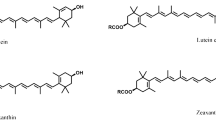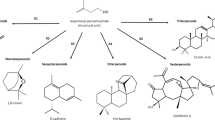Abstract
A new, simple and efficient analysis method for fresh plant in vitro cultures—namely, high-speed homogenization coupled with microwave-assisted extraction (HSH–MAE) followed by liquid chromatography–tandem mass spectrometry (LC–MS/MS)—was developed for simultaneous determination of six alkaloids and eight flavonoids in Isatis tinctoria hairy root cultures (ITHRCs). Compared with traditional methods, the proposed HSH–MAE offers the advantages of easy manipulation, higher efficiency, energy saving, and reduced waste. Cytohistological studies were conducted to clarify the mechanism of HSH–MAE at cellular/tissue levels. Moreover, the established LC–MS/MS method showed excellent linearity, precision, repeatability, and reproducibility. The HSH–MAE–LC–MS/MS method was also successfully applied for screening high-productivity ITHRCs. Overall, this study opened up a new avenue for the direct determination of secondary metabolic profiles from fresh plant in vitro cultures, which is valuable for improving quality control of plant cell/organ cultures and sheds light on the metabolomic analysis of biological samples.

HSH-MAE-LC-MS/MS opened up a new avenue for the direct determination of alkaloids and flavonoids in fresh Isatis tinctoria hairy root cultures


Similar content being viewed by others
References
Hamburger M (2002) Isatis tinctoria – from the rediscovery of an ancient medicinal plant towards a novel anti-inflammatory phytopharmaceutical. Phytochem Rev 1:333–344
Mohn T, Plitzko I, Hamburger M (2009) A comprehensive metabolite profiling of Isatis tinctoria leaf extracts. Phytochemistry 70:924–934
Mohn T, Potterat O, Hamburger M (2007) Quantification of active principles and pigments in leaf extracts of Isatis tinctoria by HPLC/UV/MS. Planta Med 73:151–156
Mohn T, Cutting B, Ernst B, Hamburger M (2007) Extraction and analysis of intact glucosinolates—a validated pressurized liquid extraction/liquid chromatography–mass spectrometry protocol for Isatis tinctoria, and qualitative analysis of other cruciferous plants. J Chromatogr A 1166:142–151
Mohn T, Suter K, Hamburger M (2008) Seasonal changes and effect of harvest on glucosinolates in Isatis leaves. Planta Med 74:582–587
Gai QY, Jiao J, Luo M, Wang W, Ma W, Zu YG, Fu YJ (2015) Establishment of high-productive Isatis tinctoria L. hairy root cultures: a promising approach for efficient production of bioactive alkaloids. Biochem Eng J 95:37–47
Steinmann D, Ganzera M (2011) Recent advances on HPLC/MS in medicinal plant analysis. J Pharmaceut Biomed Anal 55:744–757
Kole PL, Venkatesh G, Kotecha J, Sheshala R (2011) Recent advances in sample preparation techniques for effective bioanalytical methods. Biomed Chromatogr 25:199–217
Romanik G, Gilgenast E, Przyjazny A, Kamiński M (2007) Techniques of preparing plant material for chromatographic separation and analysis. J Biochem Biophys Methods 70:253–261
Chan CH, Yusoff R, Ngoh GC, Kung FWL (2011) Microwave-assisted extractions of active ingredients from plants. J Chromatogr A 1218:6213–6225
Kursinszki L, Hank H, László I, Szőke É (2005) Simultaneous analysis of hyoscyamine, scopolamine, 6β-hydroxyhyoscyamine and apoatropine in Solanaceous hairy roots by reversed-phase high-performance liquid chromatography. J Chromatogr A 1091:32–39
Wahby I, Arráez-Román D, Segura-Carretero A, Ligero F, Caba JM, Fernández-Gutiérrez A (2006) Analysis of choline and atropine in hairy root cultures of Cannabis sativa L. by capillary electrophoresis-electrospray mass spectrometry. Electrophoresis 27:2208–2215
Farhat A, Ginies C, Romdhane M, Chemat F (2009) Eco-friendly and cleaner process for isolation of essential oil using microwave energy: experimental and theoretical study. J Chromatogr A 1216:5077–5085
Hu ZB, Du M (2006) Hairy root and its application in plant genetic engineering. J Integr Plant Biol 48:121–127
Acknowledgments
The authors gratefully acknowledge financial support by the Application Technology Research and Development Program of Harbin (2013AA3BS014), the Fundamental Research Funds for the Central Universities (2572015AA14, 2572014AA06), and the Special Fund of the National Natural Science Foundation of China (31270618).
Author information
Authors and Affiliations
Corresponding author
Additional information
Jiao Jiao and Qing-Yan Gai contributed equally to this work.
Electronic supplementary material
Below is the link to the electronic supplementary material.
ESM 1
(PDF 348 kb)
Rights and permissions
About this article
Cite this article
Jiao, J., Gai, QY., Zhang, L. et al. High-speed homogenization coupled with microwave-assisted extraction followed by liquid chromatography–tandem mass spectrometry for the direct determination of alkaloids and flavonoids in fresh Isatis tinctoria L. hairy root cultures. Anal Bioanal Chem 407, 4841–4848 (2015). https://doi.org/10.1007/s00216-015-8668-4
Received:
Revised:
Accepted:
Published:
Issue Date:
DOI: https://doi.org/10.1007/s00216-015-8668-4




